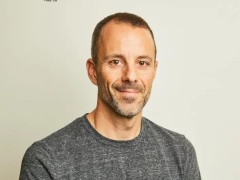
Paramount Global has a gaming problem — and Skydance Media could be the solution.
Earlier this month Paramount and its controlling shareholder Shari Redstone agreed to sell the company to David Ellison’s Skydance, which has not one but two internal game studios. The still-pending deal could serve as a catalyst boosting Paramount’s presence in gaming. Ellison, son of Silicon Valley billionaire Larry Ellison, is said to be a gamer himself who sees video games as being on a par with TV and film.
Paramount Games recently licensed rights to make an “Avatar: The Last Airbender” game here and teamed with an outside developer for a “Paranormal Activity” game there. But the division has been an afterthought since well before the second merger between Viacom and CBS to create Paramount Global and at this point largely exists in name alone.
‘Deadpool & Wolverine’ Underscores MCU’s Much-Needed Evolution

Amazon Prime Video Buys U.K.'s Historic Bray Studios, Where 'Rings of Power' Season 2 Was Filmed
“One of the big problems in this business… is growth, and Skydance takes a bunch of parts of the business that Paramount needs to get into, including games, and adds a growth engine to the company,” Jeff Shell, set to become president of the merged Paramount-Skydance, said alongside Ellison on the July 8 call announcing the proposed sale to analysts and investors.
As IDG CEO and games analyst Yoshio Osaki observes, “Being a pure licensor is not going to cut it in this market.”
Skydance Games comprises two divisions. One is the Dan Prigg-led VR studio Skydance Interactive, founded in 2016, which has produced “Archangel” and “Walking Dead: Saints & Sinners” and is planning for the fall release of original IP game “Skydance’s Behemoth” (pictured above). The other is Skydance New Media, a AAA game studio founded in 2019 by gaming industry legend Amy Hennig (the mastermind behind PlayStation and Naughty Dog’s “Uncharted” gaming franchise) and her partner Julian Beak. Next year, Hennig and Beak will launch their first title, “Marvel 1943: Rise of Hydra,” and are making a “Star Wars” game for Disney’s Lucasfilm.
Working with outside publishers, Skydance has also released the licensed VR game “Journey to Foundation,” based on the Skydance-produced Apple TV+ series “Foundation” (and has another licensed “Foundation” mobile/PC title in the works for 2025), along with PC game “Terminator: Dark Fate – Defiance,” tied to the Skydance film of the same name.

“Skydance’s advantage is they have access to some of the best transmedia brands in entertainment,” Osaki says. “But from a development track record perspective, it’s been limited so far. I think there’s a lot of promise with what Amy Hennig can bring to the table with her Marvel project. She’s one of the most well-respected game visionaries in our industry.”
In short: The quantity isn’t there yet, but the quality is. That has landed the Skydance Games team those high-profile projects with beloved IP that Hollywood doesn’t typically hand out to studios less than 10 years old.
“We’re leveraging our experience, our reputations, our relationships, our connections, all of that,” Hennig told PvNew of the Skydance New Media side of the business. “When we started this, it was just [me and co-president Julian Beak]. And the pitch [to David Ellison] was, ‘Hey, we’re going to build a whole studio.’ This was right before Covid hit, so we didn’t know the world within we’d be building that studio.”
Beak says the duo, who worked together previously for years at Electronic Arts, “fairly quickly assembled a group of people who had over 20 years of experience on average.” Hennig says that team means “they don’t want to turn the same old crank anymore, either.” “They get fired up like we were all fired up working on 8-bit consoles to solve problems that we haven’t tackled before,” Hennig says.
And that excitement, combined with Beak and Hennig’s existing close relationships within the gaming elite, including time spent developing a game with Lucasfilm at EA, are what landed Ellison’s young Skydance Games its first high-profile AAA projects.
“What we pitched to Disney more broadly, but individually to Marvel and Lucasfilm Games, was a very, very special and very specific, narrative-driven, cinematically-presented, high fidelity and inviting action-adventure game with lots of specifics, some of which we shared publicly, and they got excited, the way Amy talked about how even our staff get excited,” Beak says. “They’re like, ‘Oh, this is different. This isn’t just going to be an another skin on top of a typical X, Y or Z game.’ I guess our enthusiasm, excitement, and our specificity around what we were trying to do, it was the credible element. Their IP really gets to shine in this setup.”

Ellison boasted on the July 8 Paramount-Skydance deal call with analysts that the Skydance Games led by Prigg, Hennig and Beak — each of whom report directly to CEO Ellison on creative and to Skydance president Jesse Sisgold day-to-day — “is really pushing the boundaries of what’s possible in narrative gameplay” with state-of-the-art tech, “where we have created a proprietary AI camera system that allows you to have all of the fun of the moment to moment, second to second gameplay but present like you’re in a cinematic.”
That tech will be showcased in “Skydance’s Behemoth” from Prigg’s VR studio this fall. based on an original story from Skydance, the game takes players into “the Forsaken Lands, a kingdom reduced to rubble by an ancient curse, to fell the Behemoths. These gigantic monsters spread ruin throughout the land. Players will need to slay all who stand in their way to kill the unkillable and restore life to the once-great civilization.”
Analyst Osaki says that up to this point, a lot of what Skydance has done in the VR space “has been more incremental and more evolutionary rather than revolutionary.” Skydance is looking to change his mind with “Behemoth.”
Overseen by Skydance Interactive VP of creative Shawn Kittelsen, the “Behemoth” game was built in Epic Games’ Unreal Engine 5 and uses Skydance’s “foveated gaze-based rendering” tech, which Skydance says “lessens motion sickness through high-resolution and smooth frame rates” and offers “detailed worlds and virtual physicality for a more realistic melee combat experience.” “Behemoth” also features Skydance’s existing doll-like severing mechanic from “The Walking Dead: Saints & Sinners” updated into a new dismemberment experience where “players can cleave enemies in any direction using the world and weapons around them.”
“Being in VR means being on the cutting edge all the time,” Prigg says. “There’s no safety net of like, ‘Oh, this is how people have been doing it for 10 years.’ No, this is how people have been doing it for six months. And that makes it fun and terrifying in the same breath.
“Trying to tell stories in VR is a little bit different, because you’re immersive, you’re thinking in 360, you’re thinking about sound, you’re worrying about people being sick,” he continues. “And how do you create an amazing experience where you’re not derailed? So all that tech, using Unreal 5, all the latest SDKs (software development kits), really pushes the boundaries for us on a monthly basis of what’s coming up down the pipe and what does the future look like, and how do we continue to push that envelope. It’s exciting to be like, let’s see if we can do grappling in this just like they did in ‘Spider-Man,’ and what is that going to look like? And then, how do we not make you sick?”

If some of this terminology has been flying over your head, don’t worry: Beak says the Skydance Games leadership team “wish there was a Google translate between gamer speak and random-media-company-executive speak in some of the places we were before, but we don’t have to do that translation with David,” noting Ellison has “played prototypes of stuff we’ve done and been able to sit down and give us thoughtful feedback on the dimensions that are so important to our overall priorities.”
Prigg emphasizes that Ellison’s familiarity with the sector makes an enormous difference for Skydance Games.
“I’ve worked for companies where I was the highest-ranking gaming executive, and then I reported into someone who worked at Coca-Cola,” Prigg says. “So it really does come from David at the top. David is a gamer, and that helps tremendously. He treats gaming as he would movies and TV — this is storytelling and entertainment. And we’re just specialists in our medium. All those things helped us build the studio from scratch. I don’t know if I would even attempt to try to go to another kind of media company who didn’t understand games and them be like, ‘All right, make me a game studio.’ It’d be like, ‘Dance, monkey!'”
With gaming industry revenue hitting $227.6 billion in 2023, according to PwC, and projected to cross $300 billion in five years, there are in fact plenty of media companies breaking into games and those already in that world doubling down on their existing assets. And then there’s Paramount.

Though its weak gaming business is far from Paramount’s most pressing issue these days, it becomes more glaring in comparison to the recent moves made by its Hollywood competitors Warner Bros. Discovery (which maintains an in-house games division churning out titles based on its DC, “Harry Potter” and “Mortal Kombat” IP), Disney (through its new stake in “Fortnite” maker Epic Games), NBCUniversal (through its partnership with Funko to pack the new “Funko Fusion” game with “Jurassic Park,” “Chucky” and more Universal content), and Netflix and Amazon (both of which have been rapidly making announcements and promises on their respective young gaming segments).
“Paramount absolutely needs to invest more heavily in strong game development teams,” IDG’s Osaki says. “Gaming is taking share away from the other transmedia verticals, which is why Disney, NBCUniversal, and some of these other entertainment competitors, are probably revisiting their own game strategy to become a more full-fledged game publishing operation moving forward. Directionally, things are moving in reverse now. In the early days, you would have a lot of non-gaming IPs get translated into games, but often with lower quality. But now, a lot of the biggest transmedia IPs are originating from the games space and moving into TV and film and other pieces of content: HBO’s ‘The Last of Us,’ Amazon’s ‘Fallout,’ ‘League of Legends’ with ‘Arcane’ on Netflix, the ‘Super Mario Bros. Movie.’ So if I’m Skydance acquiring Paramount, I need to look at Paramount brands and find a way to harness them into games — but I also need to think about investing resources into games-originated IP that could then be reverse engineered into film and TV later on.”
Osaki also believes that Skydance Games’ dual offering of a VR studio and AAA game studio is a healthy strategy moving forward, though the balance shouldn’t be 50-50.
“VR had a huge hype bubble that burst in 2016-2017,” Osaki says. “The expectations were way too high versus the actual growth of that market. And now it’s the opposite. VR actually has grown pretty solidly over the last few years against the low base. But the sentiment is more negative than the fundamentals of that business. So, it’s growing solidly, but it’s still niche. And when I look at VR gaming, it’s a meaningful opportunity, but the total addressable market size (TAM) is still fractional compared to overall non-VR games opportunities.”
Without speaking specifically to all the possibilities of mining Paramount IP that could happen if Skydance Games became Paramount’s de facto in-house gaming studio through Skydance’s pending acquisition, Hennig says just the fact Paramount president-to-be Jeff Shell brought up the gaming power at Skydance when announcing the deal is a giant step for the gaming industry’s reputation in Hollywood.
“We love partnering with blockbuster IP that we love. We’ve already done that with Marvel and Lucasfilm and any opportunities to do that with any other partners we certainly welcome,” Hennig says.
In a perfect world, this is what could come of the Skydance-Paramount merger, in terms of gaming, TV and film development, according to attorney Simon Pulman, partner and co-chair of Pryor Cashman’s media and entertainment and film, TV and podcast groups.
“This is something that’s easier said than done, but really thinking in terms of being strategic in how you develop IP in a synergistic way,” Pulman says. “Ideally, the games team is talking to the film and television team. They’re operating independently, but they’re looking for opportunities to build value, to build IP, possibly in game first with an eye to film and television down the line. There’s no doubt that a best case scenario is to create a virtuous circle where you’re bringing in new fans through, for instance a film or television adaptation, and then feedback for the game and so on and so forth. And if you look at the numbers in terms of the bump and the adoption that all of the ‘Fallout’ games got after the show came out, that’s living proof of how these things can become a rising tide that lifts all boats.”
Setting the Paramount merger factor aside, Skydance Games leaders are focused on shortening the development and production process while still maintaining high standards.
“We don’t want to spend five or six years making the game — that’s silly,” Hennig says. “We’d love to have games out on what used to be a two-year cadence. Maybe 30 months is more sane. But not five years. And games don’t have to be as massive and all things for all people. The idea that we can attack something with focus and understand the thing that we’re trying to make and the scope and size of it, and get those things out on a quicker cadence, and have more at-bats.”






